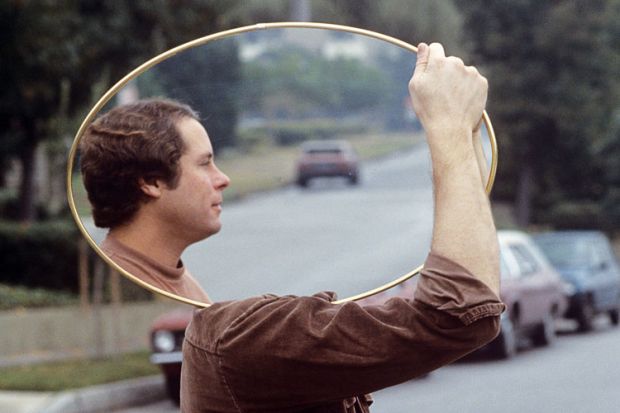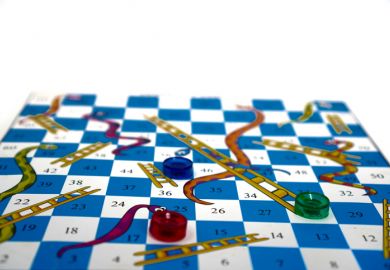Source: Rex/Getty
Here’s looking at you: can colleagues really be objective in their assessment of each other’s teaching when they know they have to work together for the rest of the year?
With nine out of 10 students happy with the teaching they receive, you might imagine that universities are pretty confident about what is on offer in their classrooms.
But despite high marks achieved in the National Student Survey each year (91 per cent of students call their lessons “intellectually stimulating”) and in institutions’ own checks via internal questionnaires, it seems that doubts about the quality of university teaching still linger.
Plans are afoot to track students’ “learning gain” in order to measure the impact of teaching, while the current system of quality assurance is being reviewed amid concerns that there may be insufficient scrutiny of some parts of higher education.
Many universities have also been quietly stepping up their use of teaching observations.
Several institutions have introduced policies to ensure that there is peer observation of lessons across the entire university, setting out how often staff should be scrutinised by their colleagues.
The University of Liverpool, which revised its policies in November, now requires every member of staff to be observed at least once every two years, with staff on probation facing annual observations.
Another institution set to increase the frequency of teaching observations is Southampton Solent University, which is due to introduce more systematic use of peer review as part of its strategic review.
However, Solent’s vice-chancellor, Graham Baldwin, is keen to emphasise that the observations are not about “checking up” on teaching – rather, on improving it.
“I have benefited hugely from observing other people’s classes, as well as being observed myself,” said Professor Baldwin, who has taught in secondary and further education, as well as at universities. “People observing gain as much as those being observed,” he added.
Even highly experienced teaching staff will benefit from regular teaching observation from peers, said Professor Baldwin, who took charge at Southampton Solent last August. He added that peer observation could also help with the “huge challenge” of introducing emerging technology into classrooms.
But does peer observation really improve teaching? Do staff really give honest, unflinching criticism to their colleagues, knowing that they have to work with them for the rest of the year?
Is there a case for having external observers involved in the process? Could, in fact, an Ofsted-style system of checks better guarantee standards for students in the age of £9,000 tuition fees?
Professor Baldwin said he was opposed to any such system, stating that staff “get more out of internally run observations than external ones”.
Geoffrey Alderman, professor of history at the University of Buckingham and a former pro vice-chancellor for academic standards at the University of London, agreed.
As part of the Teaching Quality Assessment programme to monitor university standards in the 1990s, Professor Alderman visited several universities to sit in on classes and observe their quality.
“We toured universities old and new, even observing one-to-one tutorials at Oxford,” recalled Alderman of the efforts to address concerns about former polytechnics’ ability to teach to university-standard levels. But, he said, “the high scores flowed like confetti at a wedding”, and he thought the exercise a “gigantic waste of time”, which cost about £20 million in total before it was scrapped in the late 1990s.
Universities are very good at fixing such inspections to ensure high marks, rendering them meaningless, Professor Alderman explained, saying that internally run observations are a far better way to uphold teaching quality.
However, he said he believed that some small or recently established higher education providers could benefit from outside checks as they “lack the critical mass” to run effective checks themselves.
“I do know one or two semi-informal arrangements in small subject areas where lecturers have agreed to observe teaching at each other’s institution,” he said.
Box-ticking exercise
Matt O’Leary, principal lecturer in post-compulsory education at the University of Wolverhampton, whose research focuses on teaching observations, also believes that external teaching checks would be a mistake.
“If the Quality Assurance Agency or another regulator took it over, peer observation would become relatively meaningless and just a box-ticking exercise for institutions,” he said.
He added that universities should also be careful about how they use peer observations, as they seldom work as both a teaching improvement tool and a quality check.
Instead, universities should seek to improve the training they give to peer observers as existing arrangements were often “ad hoc” and not consistent across different departments.
Many observers do not know what to look for when sitting in on tutorials, with many going on their instincts about a lesson, said Dr O’Leary.
“People often judge teachers as they would an X Factor contestant – it’s often about whether they like them or were amused by the lesson,” he explained. “They also might be thinking, ‘I wouldn’t do it like that’, and not examine whether their hard-wired instincts might be incorrect.”
Dr O’Leary added that assessing a colleague’s teaching style can be tricky as one lesson may not give a good indication of how well they are doing.
One indicator that observers often note is how many students in the class participate in group discussions. “If you have three or four students in a class who do not make a contribution, does that tell you that they are not engaging with the subject or lesson?” Dr O’Leary asked.
“It might be that those students like to mull things over before they get involved in a discussion.” One way to get around this might be for observers to find out if these quieter students are submitting high-quality work related to that class.
One-off observers may also fail to understand the dynamics of a particular classroom, he added. “A teacher might be very stern and hard with one student, but treat another with kid gloves,” he said.
“It might seem harsh to an outsider, but that lecturer might have very good reasons for treating different students in different ways,” he explained.
Most academics are likely to be relaxed about having a friendly colleague offer constructive comments on their classes, even if it invites criticism of their teaching methods.
However, if observations become another form of monitoring, benchmarking or performance management, academics will surely look less kindly on another round of hoop jumping.
Register to continue
Why register?
- Registration is free and only takes a moment
- Once registered, you can read 3 articles a month
- Sign up for our newsletter
Subscribe
Or subscribe for unlimited access to:
- Unlimited access to news, views, insights & reviews
- Digital editions
- Digital access to THE’s university and college rankings analysis
Already registered or a current subscriber? Login





